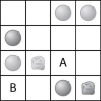After reading the paragraphs below, answer the questions that follow.
During a summer study abroad program, you travelled to Austria to study genetics at the University of Vienna. While you were there, a momentous discovery was made: some of Gregor Mendel's original lab books and notes were found to be buried outside of the abbey where he lived. It just so happened that the professor you were working with obtained copies of these notes and enlisted your help to decipher them.
You hired a translator to translate Mendel's notes from Czech to English, and using your knowledge of modern genetics (which Mendel did not have!) you were able to construct a partial Punnett square (shown below) . Because the notebook was damaged from being buried for so long, this is the only information that you have regarding a cross that Mendel must have performed. Your professor has tasked you with figuring out more about this experiment.

-In pea plants, round peas are dominant (R) and shriveled peas are recessive (r,) and yellow peas (shown as light gray in Punnett square) are dominant (Y) and green peas (dark gray) are recessive (y) . Using this information and the partial Punnett square above, what phenotype should be in the square labeled B?
Definitions:
Q8: When a cell uses fatty acids for
Q15: Which part of a bone contains the
Q17: Which hormone prevents a seed released in
Q20: Put the following steps of the light
Q38: The evolution of the vertebrate skeleton system<br>A)originated
Q40: Which of the following molecules is a
Q42: The "halves" of an individual peanut, which
Q60: Using a six-sided die, what is the
Q62: What type of energy would the leg
Q72: Why don't the grafted hybrids produce apples